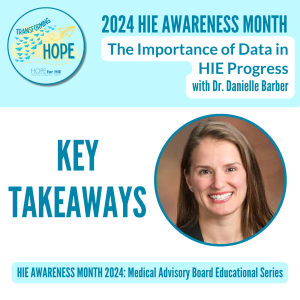
We’ll start with where we are. HIE is not a one-size-fits-all condition, and there is no one-size-fits-all treatment approach. Aside from cooling, which has only been considered the standard of care for the last two decades and is not universally available, equitable, and effective in treating all HIE babies, we need a combination of interventions precisely tuned to work together to achieve the best outcomes.
Now, let’s look at where we’re going. Yes, HIE is complex, but within this complexity lies tremendous opportunity: the sky is the limit regarding research aimed at optimizing the care and outcomes of these babies. Notable researchers and healthcare professionals are dedicating their careers to this cause, and believe us when we say they are generating significant momentum in the field.
Four of these researchers — Dr. Lina Chalak, Dr. Kenji Cunnion, Dr. Nikki Robertson, and Dr. Brian Kalish — met with Hope for HIE to share some behind-the-scenes insights into the revolutionary work they are doing to improve the landscape of HIE treatment and care.
Missed the live stream Q&A? No worries. We took notes, and like any good partner, we are willing to share! Read our key takeaways below.


The global pursuit of HIE treatments is continuously evolving, but there’s a growing consensus amongst the research community that a community-driven approach, or one that operates using patient-family and advocacy organization input, is essential to shaping, designing, and conducting these studies in a way that better reflects and responds to the real needs and experiences of those affected.
Not only does this collaborative approach enhance the quality and focus of research, but it also creates opportunities for researchers and healthcare professionals to pool their knowledge and resources to explore the safety and efficacy of potential therapeutic and pharmacological treatments across all phases of an ischemic event, not just those implemented immediately after birth.

That’s what’s so exciting about the following research endeavors—they demonstrate interest not just in the early acute phase of brain injury, where the focus has been historically, but also in the subacute and chronic, more rehabilitative phases of HIE.
Let’s review some details of their work below:
Status: Active
The research question: Dr. Lina Chalak explains that mild HIE is not always mild; some babies who are labeled as having mild HIE can and do have a later insult, but there are currently no studies with conclusive evidence to tell us that hypothermia works in babies with mild HIE the same way it does with those categorized as moderate to severe. So, the question remains: how can we better understand the effectiveness of hypothermia in mild HIE cases and ensure optimal treatment for these infants?
The protocol: This trial is unique because it alleviates the pressure to obtain parental consent within the first 6 hours of that injury by involving both cooling and non-cooling sites. Cooling sites aim to track the trajectory of mild babies, while non-cooling sites can provide valuable data on outcomes without cooling.
Moderate to severe HIE have clear indicators, especially with a higher amount of abnormalities on the Sarnat exam and the presence of one or more seizures within the first 6 hours of that injury. So, to identify mild babies, especially ones with a later ischemic onset, they look for a buildup of acid in the blood, and they begin an early EEG intervention to look for any evidence of electrographic seizures. This has already led to an interesting discovery: the early act of EEG monitoring has allowed doctors and researchers to track a significant amount of babies — approximately 25% thus far — who are having electrographic seizures without the clinical manifestation of those seizures. With parental consent, these babies can receive cooling when they otherwise would not have had that therapeutic intervention.
The influence of patient-family input: Patient-family input has significantly influenced recruitment in the trial. Previously, recruitment faced challenges due to the narrow 6-hour timeframe following the injury. These challenges, compounded by factors such as the mother’s recovery time and difficulty digesting necessary information to make informed decisions, hindered the recruitment of a large enough cohort of babies for meaningful analysis. Discussions with parents who have experienced similar pressures have led to a considerable increase in the consent rate compared to previous studies. In fact, with a consent rate of 75% and approximately 50 babies recruited, the trial is well-positioned to provide valuable insights.
The future direction of this research: It’s exciting to know that we’ll have some answers in just two years: is this a small or big effect size? Is cooling in mild HIE babies harmful? Do we need to do more studies?
This study will also allow for secondary analyses of its data, including the long-term trajectories of school-age outcomes.
Status: Active
Research Question: Ischemia is inflammatory: when there’s a restriction in blood supply to tissues, which leads to a decrease in oxygen and nutrient delivery, the body, in the act of protection, begins to produce inflammatory mediators to increase blood flow to the affected area, recruit immune cells, and activate a series of repair processes. But the brain is a delicate organ; sometimes, that inflammatory response is not always sufficient to repair the damage caused by the injury, and more commonly, it can lead to excessive inflammation, worsening that initial injury and causing even more damage.
While cooling is a therapeutic intervention that helps dampen excessive inflammation in the brain, it is not readily available at all medical centers and is significantly absent in developing countries, where rates of HIE are 3 to 5 times higher. So, the question is: How can an accessible drug with anti-inflammatory qualities be created and implemented at the time of the acute injury to lessen the extent of its damage?
The protocol: The study follows a placebo-controlled trial design, where some infants receive the active study drug while others receive a placebo alongside hypothermia treatment. Researchers across multiple medical centers will collect various data points, including neurological function, brain imaging, and long-term neurodevelopmental outcomes.
The influence of patient-family input: Regulatory agencies, like the FDA, rely not only on the scientific evidence from the study but also on the feedback provided by involved families. The information they provide helps them better understand the safety profile of the study drug.
The future direction of this research: Regulatory approval opens up opportunities to improve the lives of babies and their trajectory in other health conditions where we currently lack effective tools.
Status: Upcoming
Research question: Melatonin, a hormone produced naturally in small amounts by our bodies, acts as a signal to help train our body’s internal clock. But when melatonin is administered in very high doses—much higher than our bodies naturally produce—it has protective effects. Dr. Robertson likens it to a mitochondrial tonic that helps cells produce energy more efficiently and can potentially lessen the damage caused by harmful toxins and mediators generated during a brain injury. So, the question is: Can a high-dose melatonin treatment administered in a specific therapeutic window improve outcomes for infants with HIE?
The protocol: Researchers will work to determine the optimal dosage and the best therapeutic window— the time frame during which melatonin treatment is most effective — to administer the high-dose melatonin. As you can imagine, conducting trials with infants requires a cautious approach, so while they have hypothesized an effective dosage, they have to start with a much lower one, typically around one-fourth of the anticipated effective dose, to ensure no adverse effects are associated with each dosage level. They will gradually increase the dosage, carefully monitoring for any signs of adverse effects, until they reach the hypothesized therapeutic level that is both effective and safe for the infants involved in the trial.
The influence of patient-family input: Getting across complicated information in a time-pressured and stressful situation to families requires that it’s packaged in bite-sized, appropriate pieces. Working with parents who’ve been through the experience and know what it’s like to take in that complex information has proven extremely helpful in developing a plan to break down that information for enrolled patient families.
The future direction of this research: This is a high-income setting trial, but Dr. Robertson and her team are actively discussing using it in one of their upcoming monotherapy trials with the Global Network and other centers in Sub-Saharan Africa.
She also wants to examine stem cells in conjunction with melatonin, especially as melatonin seems to provide a tonic for the stem cells to ramp up their regenerative and repairing abilities.
Status: Upcoming
The research question: While metformin is widely known for treating Type II diabetes, it has been gaining attention as a potential therapy for brain injuries, as they have demonstrated the ability to stimulate the production of neural stem cells and support brain plasticity. Clinical trials in older children with brain injuries, such as those from cranial radiation for tumors, have also shown benefits, sparking interest in its potential for HIE treatment in infants.
After therapeutic hypothermia and in the more chronic phase of HIE, there’s a significant period of plasticity that remains untapped, and that’s where the administration of this drug would come in — which prompts the question, can metformin accelerate recovery and promote neurorehabilitation in infants with HIE?
The protocol: Unlike other trials, metformin would not be administered in conjunction with cooling but during recovery. Researchers will work to determine the dosage of metformin and the timing of administration after cooling and monitor for any adverse effects.
The influence of patient-family input: By involving families from the outset, researchers have refined the study protocols and procedures to accommodate families’ concerns and preferences. Families have provided critical feedback on the study’s informed consent process, helping to ensure that it is clear, understandable, and respectful of their circumstances.
The future direction of this research: Like other trials, there is an interest in studying long-term neurodevelopmental outcomes, brain imaging, and biomarkers to evaluate the effectiveness of metformin in reducing brain damage and improving outcomes and trajectory in babies with moderate to severe HIE.

Progress is happening, and it’s happening now. Since the introduction of cooling therapy, our understanding of this complex condition and our ability to research various treatment therapies has grown tremendously.
And that’s not just because we have amazing doctors and researchers putting in the work; it’s also because of parents’ invaluable and active role in guiding doctors through the intricacies of their child’s development. Their input is vital, shaping the direction of research and ensuring that it remains grounded in the real experiences of those affected by HIE.
Looking ahead, the future priorities of research are clear. We must continue to explore and refine our understanding of HIE, recognizing that every baby is unique and that what works for one may not work for another, and this can only be done through a collaborative approach where medical professionals and families work hand in hand.

That place is Hope for HIE’s Clinical Hub. It brings together the best resources we know of, reviewed by our Medical Advisory Board, to help the HIE community understand as much as possible about participating in research and potential treatments, medications, therapies, and interventions aimed at improving the quality of life for children and families impacted by neonatal and pediatric-acquired Hypoxic Ischemic Encephalopathy.
As you look to this resource to provide you with tangible hope for additional therapeutics and changes in clinical care, remember that these advancements cannot happen without the active involvement of our community.
To watch the full live stream, visit our YouTube channel below, or click on our Key Takeaways for an at-a-glance view of this session!
Connect with families, read inspiring stories, and get helpful resources delivered right to your inbox.